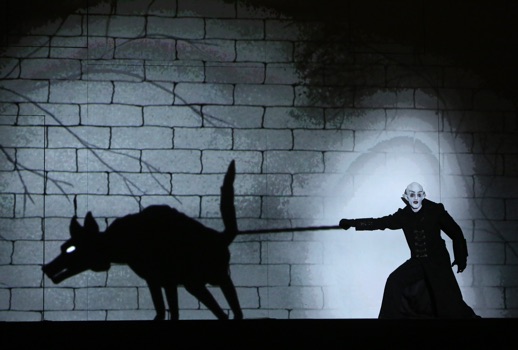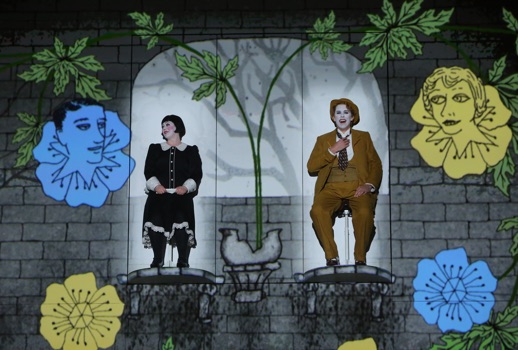

Conceived by the Australian Director Barrie Kosky for his first season as head of the Berlin Komische Oper this was so highly touted at its debut there that LA Opera hastily scrapped the planned revival of their two decade-old Gerald Scarfe staging to import it to L.A. Critical cheers and sold out houses followed quickly on and it’s easy to see why since this production succeeds as the near perfect hybrid of operatic stage and silent screen magic—surely what LA Opera has strived to give this celluloid obsessed industry town all along.
Mr. Kosky has been aided by collaborators and founders of the UK theatre group “1927” Suzanne Andrade and animator Paul Barritt in bringing this traversal of Mozart’s singspiel to the big screen… literally.
The stage of the Dorothy Chandler Pavilion has been transformed into a movie theater with a rebuilt proscenium (to hide the chorus in tiers on both sides behind black scrim) and a red velvet curtain. It rises to reveal a movie screen where all of the action takes place. The singers emerge strapped (very securely I can only pray) to 180 degree revolving doors as they stand on wee plinths, sometimes three stories above the actual stage, so that they can appear within the framework of all the animation. This allows for an opening scene with Tamino being not only chased by the dragon but actually ending up, with the Three Ladies, in the monster’s belly. So unexpected and hilarious was this effect our section of the audience was “shushed” by some blowhard who actually wanted to hear the music.
Vintage cinematic homage abounds in the witty costumes of Esther Bialas who also designed the set. Pamina is Louise Brooks, Buster Keaton as Papageno, and a truly mirthful Monostatos represented as a dead ringer for F.W. Murnau’s Nosferatu. The biggest conceit to the silent screen era is that all of Emanuel Schickenaeder’s dialogue has been left on the cutting room floor in favor of animated intertitles which the singers mime to in pure 1920’s fashion. If that weren’t amusing enough, these scenes are it’s underscored by excerpts from two of Mozart’s keyboard fantasias played on what I can only describe as a whorehouse pianoforte.

The most welcome revelation was that putting everyone right at the front of the stage and standing them in front of a wall gives the voices the most clarity I’ve ever heard in this theatre which isn’t renowned for its acoustics.
Perhaps that was part of the reason the LA Opera Chorus made such a strong impression. The brought great warmth and a rich tone with beautiful delineation between the parts to their few pieces. Without precision and attention to detail Mozart’s choral work can sound perfunctory and here the final chorus, which has always made me think of Beethoven more than Mozart, was, for once, very moving and a fitting finale.
Ben Bliss was prince Tamino and he has a very dulcet, if short-ranging, tenor that remained even and cool throughout. His phrasing was good but I longed for a little more expansion at the top of the voice during the scene in front of the temple.

Being shorn of his dialogue as Papageno put Jonathan Michie at a disadvantage but he sang and acted with more good grace than the average birdcatcher. His reactions and business where he rescued Pamina from Monostatos were very funny and the whole lead up from his suicide to the duet with Papagena sparkled. Minus the “crone” scenes (which I’ve always found tedious, frankly) Vanessa Becerra made a charming bird bride.
The Sarastro of Wilhelm Schwinghammer seemed to be having an off night. Perhaps he was uncomfortable up on his lofty perch. It was obvious he was striving to keep the voice moving, but his singing lacked legato.
I’m happy to report that the one performer who seemed to be lacking nothing was So Young Park as a crackling good Queen of the Night. Rock-solid tone from the very first betrayed not a hint of nerves. The voice is of generous size with excellent staccatos and stunning accuracy in the Vengeance Aria. If she squeaked the first high F in Act I she more than made up for it in Act II when she fired off the rest full on and with gusto. The audience burst into sustained cheers. The fact the she did all of this while strapped to a wall three stories in the air and wearing a terrifying insect head representing nothing less than an enormous spider is almost unimaginable. Brava!

James Conlon served up another excellent pre-game pep talk and I swear sometimes I’m sorry when the opera’s about to start and he has to take his leave. Pearls from this lecture included a brief overview of the Masonic clues in the score and the fact that it was one of the first operas scored for trombone, which was not considered a “secular” instrument.
His conducting was certainly up to his usual standard. once he got the horns warmed up for the second half of the overture. He led a reading that favored close attention to dynamics and especially dotted rhythms which kept his young cast alert and sounding that way.
Although this staging couldn’t be called traditional it’s musical performances are strong and it captures the wonder of the fairy tale story in ways that I have never seen a production do before.
Photos: Craig T. Mathew
Call for submissions: parterre box‘s new Talk of the Town
parterre box is launching a new themed regular feature curated by our readers and opera fans across the world! We are asking for your favorite clips, recordings, and anecdotes to get people chatting, listening, and thinking.
parterre box is launching a new themed regular feature curated by our readers and opera fans across the world! We are asking for your favorite clips, recordings, and anecdotes to get people chatting, listening, and thinking.
-
Topics: barrie kosky, los angeles opera, review
Reach your audience through parterre box!
parterre box, “the most essential blog in opera” (New York Times), is now booking display and sponsored content advertising for the 2023-2024 season. Join Carnegie Hall, Lincoln Center, Warner Classics and many others in reaching your target audience through parterre box.
parterre box, “the most essential blog in opera” (New York Times), is now booking display and sponsored content advertising for the 2023-2024 season. Join Carnegie Hall, Lincoln Center, Warner Classics and many others in reaching your target audience through parterre box.
parterre in your box?
Get our free weekly newsletter delivered to your email.

























Comments